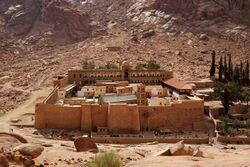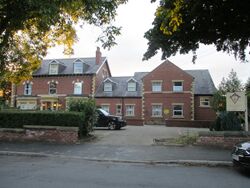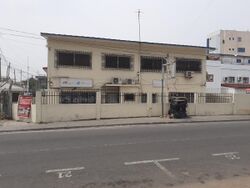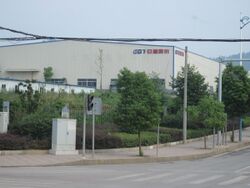Engineering:List of building types
From HandWiki
Short description: None
Residential
Single-family detached
Examples of single-family detached house types include:
- Bungalow
- Central-passage house (North America)
- Chattel house (Caribbean)
- Cottage (various)
- Courtyard house (various)
- Konak (Asia)
- Log house (various)
- Mansion (various)
- Housebarn (various)
- Split level home (various)
- Upper Lusatian house (Europe)
Single-family attached (small multi-family)
- Duplex, semi-detached, double-decker, or two-family
- Triplex, triple-decker or three-family
- Quadplex, quadruple, or four-family
- Townhouse or terraced house
Large multi-family (apartments/flats/condos)
- Garden or walk-up apartments: 1–5 stories, 50–400 units, no elevators[1]
- Mid-rise apartments/condos: 5–9 stories, 30–110 units, with elevators[1]
- High-rise apartments/condos: 9+ stories, 100+ units, professionally managed[1]
- Special-purpose group housing[1]
- Retirement home
- Nursing home
- Dormitory
Public
- Official residence
- Palace
- Archbishop's Palace
- Bishop's Palace
- Electoral Palace
- Episcopal Palace
- Presidential palace
- Residenz
Commercial
Commercial buildings, generally, are buildings used by businesses to sell their products to consumers.[1]
Office
Office buildings are generally categorized by size and by quality (e.g., "a low-rise Class A building")[2]
- Office buildings by size
- Low-rise (less than 7 stories)
- Mid-rise (7–25 stories)
- High-rise (more than 25 stories), including skyscrapers (over 40 stories)
- Office buildings by quality[3][4]
- Trophy or 5-star building: A landmark property designed by a recognized architect
- Class A or 4-star building: Rents in the top 30-40% of the local market; well-located; above-average upkeep and management; usually older than a trophy/5-star building
- Class B or 3-star building: Rents between Class A and Class C; fair-to-good locations; average upkeep and management
- Class C or 2-star building: Rents in the bottom 10-20% of the local market; less-desirable locations; below-average upkeep and management
- 1-star building: Does not meet the needs of typical tenants; may be obsolete and/or in need of significant renovation[3]
Retail
Retail buildings are categorized by their configuration and size[5]
- Non-freestanding (also known as shopping centers or shopping malls)
- Super-regional shopping center: enclosed space; 800,000+ sqft; 5+ anchor stores with other tenants that sell a very large variety of goods
- Regional shopping center: enclosed space; 400,000–800,000 sqft; 1–5 anchor stores with other tenants that sell a large variety of goods
- Community shopping center: open space; 125,000–400,000 sqft; provides general merchandise and commodities (e.g., supermarket, discount department store)
- Neighborhood shopping center: open space; 3,000–125,000 sqft; provides commodities to nearby neighborhoods (e.g. drug store)
- Strip or convenience shopping center: open space; less than 30,000 sqft; located along suburban transportation arteries on shallow land parcels; a strip may be configured in a straight line, or have an "L" or "U" shape
- Lifestyle center: "Main Street" concept with pedestrian circulation in core and vehicular circulation along perimeter; upscale national chain specialty stores, dining or entertainment (e.g. The Grove, Los Angeles, CA; Americana at Brand, Glendale, CA)
- Freestanding: any stand-alone retail structure that is not part of a complex
- Big box: freestanding category-dominant retailer; 50,000+ sqft (e.g. The Home Depot, Target, Walmart)
- Power center: among the largest types of retail properties; 3+ big box anchor stores; multiple large buildings with parking lot in front and loading in back; smaller retailers usually clustered in a community shopping center configuration
- Retail outlet: manufacturers' outlet stores; 50,000–400,000 sqft
- Pop-up retail: a retail location designed to only be in a location temporarily (e.g., a retail store that only opens during a holiday season)
Hotels
- Full service hotel
- Travelers' hotel
- Motel
- Choultry
- Caravanserai
- Extended stay hotel
- Boutique hotel
- Casino
- Resort
Special-purpose
- Theme or amusement park
- Aquarium
- Bar (establishment)
- Bowling alley
- Car wash
- Funeral home
- Marina
- Self-storage
- Theater
- Zoo
Industrial
Industrial buildings are primarily used for the production and storage/distribution of goods, among other uses.[6]
- Factory
- Mill
Manufacturing
- Light manufacturing
- Heavy manufacturing
Warehouse/distribution
- Warehouses
- Bulk
- Ice house
- Cold/cool/refrigerator/freezer storage
- High-cube
- Warehouse store
- Distribution/fulfillment centers
- Container terminals
Flex space
- Office building
- Laboratory
- Data center
- Call center
- Showroom
Infrastructure
- Composting
- Desalination plant
- Waste transfer
- Power generation
- Power plant
- Thermal power plant
- Fossil-fuel power station
- Nuclear power plant
- Geothermal power
- Biomass power plant
- Renewable energy power station
- Power distribution
- Transmitter building
- Dams
- Pump house
Agricultural
- Abattoir
- Barn
- Chicken coop or chickenhouse
- Cow-shed
- Farmhouse
- Granary, Hórreo
- Greenhouse
- Hayloft
- Pigpen or sty
- Root cellar
- Shed
- Silo
- Slaughterhouse
- Stable
- Storm cellar
- Well house
- Crib
- Windmill
- Workshop
Institutional
- Medical
- Hospital
- Nursing homes
- Mental hospital
- Sanatorium
- Educational
- Archive
- College
- Elementary schools
- Orphanage
- Secondary School
- School
- University
- Nursery school
 A mudhif near Lagash, Iraq
A mudhif near Lagash, Iraq
- Civic
- Arena (or stadium)
- Library
- Mudhif: a traditional reed house made by the Madan people of Iraq
- Museum
- Observatory
- Community hall
 A monastery in the Sinai Peninsula, Egypt
A monastery in the Sinai Peninsula, Egypt
- Religious Facilities (Place of worship)
- Government
- City hall
- Consulate
- Courthouse
- Embassy
- Fire station
- Meeting house
- Moot hall
- Parliament house
- Police station
- Post office
- Assembly
- Military
- Arsenal
- Barracks
- Bunker
- Blockhouse
- Citadel
- Missile launch facility
- Transport
- Airport
- Bus station
- Metro (subway, underground) station
- Taxi station
- Railway station (or, primarily in US, Railroad station)
- Signal box
- Lighthouse
- Shipyard
- Spaceport
- Hovercraft
- Passenger terminal
- Boathouse
- Parking garage
- Hangar
- Historical
- Other
- Aul
- Bathhouse
- Film studio
- Folly
- Gym
- Pavilion
- Shelter
Other
- Bakehouse
See also
References
- ↑ 1.0 1.1 1.2 1.3 1.4 Schmidt, Robert (2018-11-25). "Types of Commercial Real Estate" (in en-US). PropertyMetrics. https://www.propertymetrics.com/blog/2013/02/27/types-of-commercial-real-estate/.
- ↑ Sicola, Maria (March 2017). "Office Terminology" (PDF). Commercial Real Estate Terms and Definitions. The NAIOP Research Foundation. pp. 27–31. https://www.naiop.org/-/media/Research/Research/Research-Reports/Terms-and-Definitions/CRE-Terms-and-Definitions-2017.ashx?la=en.
- ↑ 3.0 3.1 "CoStar Building Rating System". http://buildingratingsystem.com/Source/CoStar_BuildingRatingSystem.pdf.
- ↑ Kugler, Thomas. "Building Owners and Managers Association (BOMA) International" (in en). https://www.boma.org/BOMA/Research-Resources/Industry_Resources/BuildingClassDefinitions.aspx.
- ↑ Sicola, Maria (March 2017). "Retail Terminology" (PDF). Commercial Real Estate Terms and Definitions. The NAIOP Research Foundation. pp. 32–36. https://www.naiop.org/-/media/Research/Research/Research-Reports/Terms-and-Definitions/CRE-Terms-and-Definitions-2017.ashx?la=en.
- ↑ Sicola, Maria (March 2017). "Industrial Terminology" (PDF). Commercial Real Estate Terms and Definitions. The NAIOP Research Foundation. pp. 21–26. https://www.naiop.org/-/media/Research/Research/Research-Reports/Terms-and-Definitions/CRE-Terms-and-Definitions-2017.ashx?la=en.
 |













